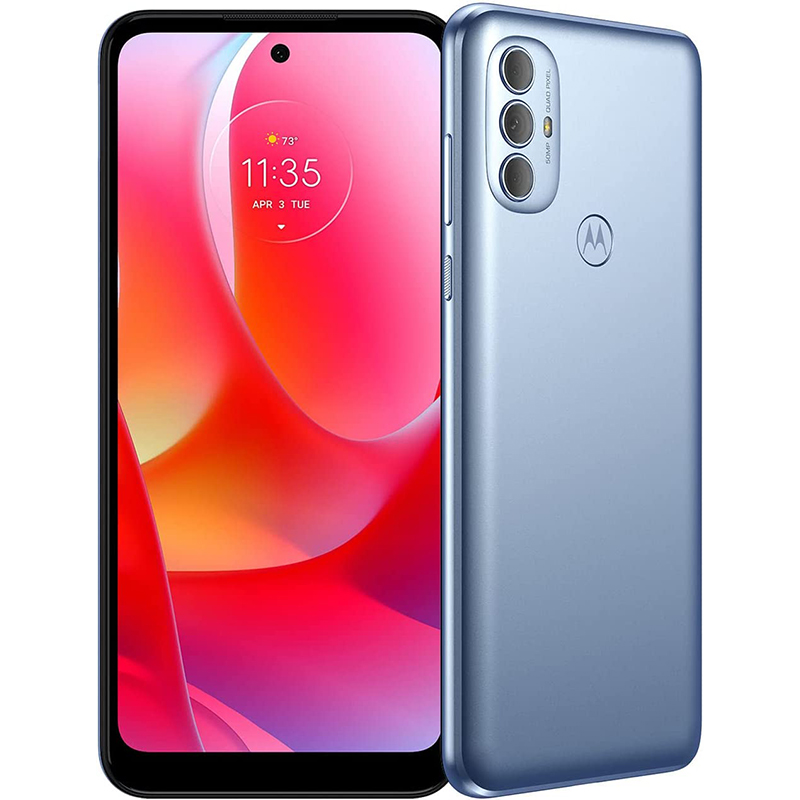Moto G Power (2022) vs. Moto G Power (2021)
The same but different.

Some notable upgrades
Motorola quickly followed up the Moto G Power (2021) with the Moto G Power (2022), and it offers some notable features that make it an enticing option to consider if you’re ready for an upgrade.
Pros
- Larger capacity option
- Better processor and more RAM
- Can be updated to Android 12
- Slightly better camera
- Much better screen refresh rate
Cons
- Slightly smaller screen
- Not everyone will like the fingerprint sensor on the back
- MediaTek processor isn't always as good as Qualcomm for games and apps

Still worth keeping
If you find certain features lacking in the Moto G Power (2021), you might find that the Moto G Power (2022) solves them. Otherwise, the Moto G Power (2021) offers plenty of the same features that make it worth holding on to until you’re ready to upgrade to something more premium.
Pros
- Qualcomm Snapdragon processor
- Slightly larger screen
- Fingerprint sensor built into the power button
- Decent battery life
Cons
- No plans for an upgrade beyond Android 11
- Older and outdated model
- Screen refresh rate is not as good
Motorola followed up the Moto G Power (2021) a year later with the Moto G Power (2022), leaving fans to wonder if they should upgrade or not. Even to this day, when considering the Moto G Power (2021) vs. Moto G Power (2022), it begs the question of which to get (if you’re buying new) or if it’s worth upgrading if you invested in the older model when it first came out.
The decision really comes down to understanding what makes them different, and we’re here to compare.
Moto G Power (2022) vs. Moto G Power (2021): How they look

The Moto G Power (2022) and Moto G Power (2021) look fairly similar to one another. The Moto G Power (2022) has a 6.5-inch ultra-wide 1600x720 HD LCD and comes in dark grove or ice blue finishes.
With a 64GB or 128GB option, there’s also the opportunity to expand storage up to 512GB via an optional microSD card. The Moto G Power (2022) has a textured back and a fingerprint reader built into the logo on the back, versus the power button on the side, like on the Moto G Power (2021).
By contrast, the Moto G Power (2021) has a slightly larger 6.6-inch 1600x720 IPS LCD with a slightly smaller aspect ratio at 19:9, versus 20:9 on the Moto G Power (2022). Finished in flash gray or polar silver, it comes with smaller storage options at 32GB and 64GB but is also expandable via an optional microSD card.

Both have a 3.5mm headphone jack, two microphones, and Type-C USB charging. They also both employ a water-repellant design, meeting an IP52 rating.
Thus, the decision with looks comes down to built-in storage, screen size and refresh rate, exterior colors, and where you prefer the fingerprint reader placement. The textured back of the Moto G Power (2022) is a nice touch, but considering you will likely (and should!) get a protective case for either, this might not matter much.
Get the latest news from Android Central, your trusted companion in the world of Android
Moto G Power (2022) vs. Moto G Power (2021): Breaking down the specs
We’ll get deeper into the nitty-gritty differences between these two phones beyond the looks, but first, let’s break down the specs.
| Header Cell - Column 0 | Moto G Power (2022) | Moto G Power (2021) |
|---|---|---|
| Colors | Dark Grove, Ice Blue | Flash Gray, Polar Silver |
| Screen Size & Type | 6.5-inch Ultra-Wide Max Vision IPS TFT LCD | 6.6-inch Max Vision IPS LCD |
| Screen Resolution | 1600x720 | 1600x720 |
| Operating System | Android 11 (upgradeable to Android 12) | Android 10 (upgradeable to Android 11) |
| Processor | MediaTek Helio G37 | Qualcomm Snapdragon 662 |
| Storage | 64, 128GB | 32, 64GB |
| Memory | 4GB RAM | 3GB RAM |
| Cameras | 50MP Rear Camera, 2MP Macro, 2MP Depth, 8MP Front | 48 MP Rear Camera, 2MP Macro, 2MP Depth, 8 MP Front |
| Water Resistance | IP52 | IP52 |
| Battery & Charging | 5,000mAh, 10W | 5,000mAh, 10W |
| Headphone Jack | Yes | Yes |
| Charging | USB Type-C | USB Type-C |
| Connectivity | 4G, Bluetooth 5.1, Wi-Fi | 4G, Bluetooth 5.1, Wi-Fi |
| Dimensions | 167.24 x 76.54 x 9.36mm | 165.3 x 75.9 x 9.5mm |
| Weight | 203 grams | 206.5 grams |
It’s clear there are many similarities between these two phones, but a couple of notable differences.
Moto G Power (2022) vs. Moto G Power (2021): How they operate

Beyond the differences noted above, there are a few big differences between the Moto G Power (2022) and Moto G Power (2021) in terms of how they operate.
The Moto G Power (2022) boasts a MediaTek Helio G37 processor, compared to the Qualcomm Snapdragon 662 processor on the Moto G Power (2021). Both are relatively lower-end processors compared to more premium phones. But many mobile games and apps focus on support for Snapdragon over MediaTek, so you might find you have a better experience with the Moto G Power (2021) in this respect.
Indeed, in his Moto G Power (2022) review, Nick Sutrich says the processor is what prevented the 2022 model from being "the best budget phone Motorola ever made."
However, the Moto G Power (2022) has more RAM at 4GB versus just 3GB with the 2021 model, which can be a deal-breaker for those who will use the phone for bandwidth and graphics intensive applications, like videos, gaming, and multitasking.
Interestingly, this might balance out by the processor difference: In his Moto G Power (2021) review, Joe Maring says the 3GB RAM is “far from ideal,” but notes that the Snapdragon 662 processor is a “fine chipset,” nonetheless.

What’s more, the Moto G Power (2022) has a 90Hz screen refresh rate compared to just 60Hz with the Moto G Power (2021). Theoretically, you should notice the difference when engaged in fast-moving action scenes in a movie or a game. But Sutrich says the display “seldom feels like 90Hz,” so this feature might not be the big differentiator it’s cracked up to be, after all.
The Moto G Power (2022) launched with Android 11 onboard, and it has recently been Android 12, bringing new Material You goodies and other UI updates. Since the Moto G Power (2021) is already a year and a half old, it came loaded with Android 10, only to be updated to Android 11. Unfortunately, that's as far as it will go, meaning you'll miss out on and UI changes that arrived with Android 12.
Both offer a decent three-day battery life and run on the My UX software, which offers the ability to do things like control certain functions of the phone using clever gestures, customize entertainment settings, and more.
Moto G Power (2022) vs. Moto G Power (2021): The cameras

These days, cameras are an important part of the smartphone equation. A good camera or camera system can sway your decision between one device or another. When it comes to these two phones, the cameras are actually quite similar.
The Moto G Power (2022) has a 50MP main rear camera, while the Moto G Power (2021) has a slightly lesser 48MP main rear camera. When it comes to the other cameras, both have 2MP macro and depth cameras, as well as an 8MP front selfie camera.
Thus, you’ll get a similar experience when it comes to photos with only a slight upgrade in resolution with the Moto G Power (2022). Both can also capture HD video at 30 FPS.
So, when it comes to the cameras, it’s pretty much a wash between these two with minimal differences.
Moto G Power (2022) vs. Moto G Power (2021): Should you upgrade?

If you have had the Moto G Power (2021) for the last year or longer, and you’re happy with it, there’s no need to upgrade. If you’re choosing between the two, the decision really comes down to weighing the main differences.
The difference in screen size is nominal, but the screen refresh rate can make a huge difference for those who are big on multitasking, watching videos, making video calls, gaming, and engaging in other intense applications.
If you prefer a front fingerprint sensor, that might be enough to sway you toward the Moto G Power (2022). Those who prefer Snapdragon processors should stick with or opt for the Moto G Power (2021), but keep in mind that it also limits you to features, functions, and the UI of the Android 11 OS.
Ideally, if you currently own the Moto G Power (2021), there’s no need to rush to upgrade to the Moto G Power (2022). You’re better off saving up and upgrading to a more premium device when your needs and budget allow. Let’s face it: Both of these phones leave much to be desired. They fall on the affordable end of the scale, and you do get what you pay for.
Once you're ready for something more, consider choosing among the best Android phones, which include options from various brands. If you want to stick with Motorola as a brand, we have also put together a list of the best Motorola phones, with some alternative options to consider once you’re ready to upgrade.

Some solid upgrades
The Moto G Power (2022) offers a few upgrades over the Moto G Power (2021), notably the inclusion of Android 12, along with more storage and a much better refresh rate. But if you’re going to upgrade, it’s better to save and go a step up.

Hang on to it
If you’re opting for an affordable phone like the Moto G Power, chances are the Moto G Power (2021) will continue to serve you well. While the Moto G Power (2022) has better refresh rate, slight design refinements, and more built-in storage, plus Android 11, it’s not enough to justify the upgrade just yet.

Christine Persaud has been writing about tech since long before the smartphone was even a "thing." When she isn't writing, she's working on her latest fitness program, binging a new TV series, tinkering with tech gadgets she's reviewing, or spending time with family and friends. A self-professed TV nerd, lover of red wine, and passionate home cook, she's immersed in tech in every facet of her life. Follow her at @christineTechCA.
